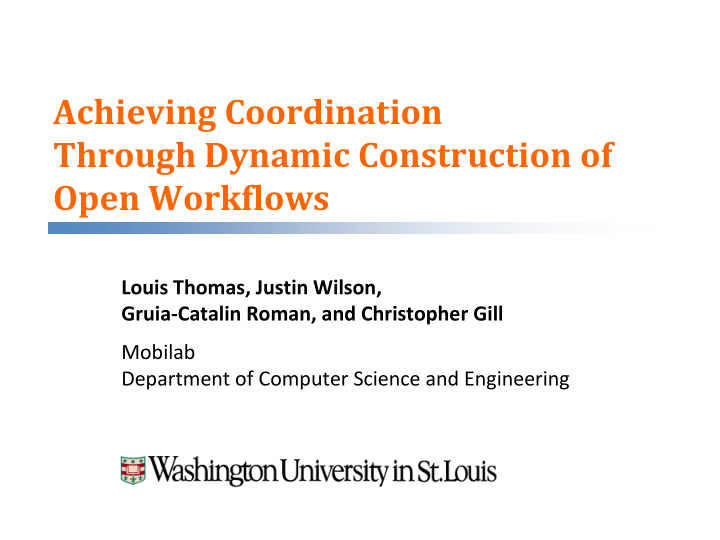



Achieving Coordination Through Dynamic Construction of Open Workflows Louis Thomas, Justin Wilson, Gruia-Catalin Roman, and Christopher Gill Mobilab Department of Computer Science and Engineering
Workflows Workflows are an established technology Coordination mechanism for integration of services A workflow is a graph of tasks that are executed to accomplish a goal Example: Printing a photo album on line Upload – Print – Bind – Deliver Goal: Use workflows for coordination in mobile ad hoc communities A more flexible approach is required 2
New Idea: Open Workflow Specify, construct, and execute a custom, context-specific workflow in response to expressed needs Respond to unpredictable and evolving circumstances Evolving community of participants Decouple task knowledge from service capability Space and time constraints Ad hoc wireless connectivity Goes beyond traditional workflow approaches 3
Open Workflow Life Cycle Construction Allocation Execution 4
Open Workflow Example Knowhow within a Community of Participants Department Chair Professor ⋁ Course Syllabus Approve Course Department Librarian Name Course Approved ⋁ ⋁ ⋀ Idea For Create Syllabus Course Book Order Book On Course Course Name List Book Reserve Register Course Course Registered Book List Course Approved 5
Open Workflow Example A workflow is constructed in response to expressed need, stated as a specification ι Course Registered ω Idea For Course Professor 6
Open Workflow Construction Algorithm Create a supergraph ⋀ ι Course Course Name Name Register Course Course Course Registered Registered ⋁ ⋁ ω Idea For Idea For Create Syllabus Syllabus Approve Course Course Course Course Course Course Approved Approved ⋁ Book Book Order Book On List List Book Reserve Professor Dept. Librarian Department Chair 7
Open Workflow Construction Algorithm Identify reachable nodes 2 5 6 ⋀ ⋀ ι Course Course Course Name Name Name 1 4 0 2 3 Register Register Course Course Course Course Registered Registered ⋁ ⋁ ⋁ ⋁ ω Idea For Idea For Create Create Syllabus Syllabus Syllabus Approve Approve Course Course Course Course Course Course Course Course Course Approved Approved Approved 2 3 4 ⋁ ⋁ Book Book Book Order Order Book On Book On List List List Book Book Reserve Reserve 8
Open Workflow Construction Algorithm Identify valid workflow 2 5 6 ⋀ ⋀ ι ι Course Course Name Name 1 4 0 2 3 Register Register Course Course Course Course Registered Registered ⋁ ⋁ ⋁ ⋁ ω ω Idea For Idea For Create Create Syllabus Syllabus Approve Approve Course Course Course Course Course Course Course Course Approved Approved 2 3 4 ⋁ Book Order Book On List Book Reserve 9
Open Workflow Allocation and Execution Allocation Participants bid to execute tasks, making firm commitments • Must be have corresponding service • Must have time in schedule to travel as necessary Execution Wait for location, time, required inputs Execute service Communicate service outputs • Move freely (so long as commitments are met!) 10
Open Workflow Middleware Architecture Execution Subsystem Construction Subsystem Workflow Auction Participation UI Initiator UI Schedule Workflow UI Location Execution Workflow Auction UI Workspaces UI Fragment UI Service Service UI Instances Communications Inter-service Messages Auction Messages Layer Service Feasibility Messages Workflow Fragment Messages 11
Open Workflow Application in Action 12
Open Workflow System Performance Time taken to construct different sized workflows in a community of four wireless devices 13
Work in Progress Expressiveness Dynamics Knowledge Management 14
Conclusions Mobile devices demand new approaches for collaboration We proposed the Open Workflow paradigm We presented a construction algorithm and an application built on the open workflow paradigm Our source code is available online http://mobilab.cse.wustl.edu/projects/openworkflow/ 15
Recommend
More recommend